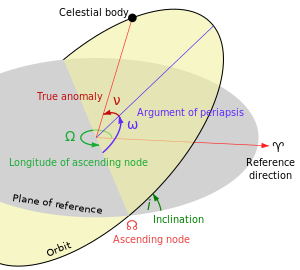


Moon · Earth
In celestial mechanics, apsidal precession (or apsidal advance)[1] is the precession (gradual rotation) of the line connecting the apsides (line of apsides) of an astronomical body's orbit. The apsides are the orbital points farthest (apoapsis) and closest (periapsis) from its primary body. The apsidal precession is the first time derivative of the argument of periapsis, one of the six main orbital elements of an orbit. Apsidal precession is considered positive when the orbit's axis rotates in the same direction as the orbital motion. An apsidal period is the time interval required for an orbit to precess through 360°,[2] which takes the Earth about 112,000 years and the Moon about 8.85 years.[3]
- ^ Bowler, M. G. (2010). "Apsidal advance in SS 433?". Astronomy and Astrophysics. 510 (1): A28. arXiv:0910.3536. Bibcode:2010A&A...510A..28B. doi:10.1051/0004-6361/200913471. S2CID 119289498.
- ^ Hilditch, R. W. (2001). An Introduction to Close Binary Stars. Cambridge astrophysics series. Cambridge University Press. p. 132. ISBN 9780521798006.
- ^ Buis, Alan; Laboratory, s Jet Propulsion (27 February 2020). "Milankovitch (Orbital) Cycles and Their Role in Earth's Climate – Climate Change: Vital Signs of the Planet". Climate Change: Vital Signs of the Planet. Retrieved 2 June 2023.